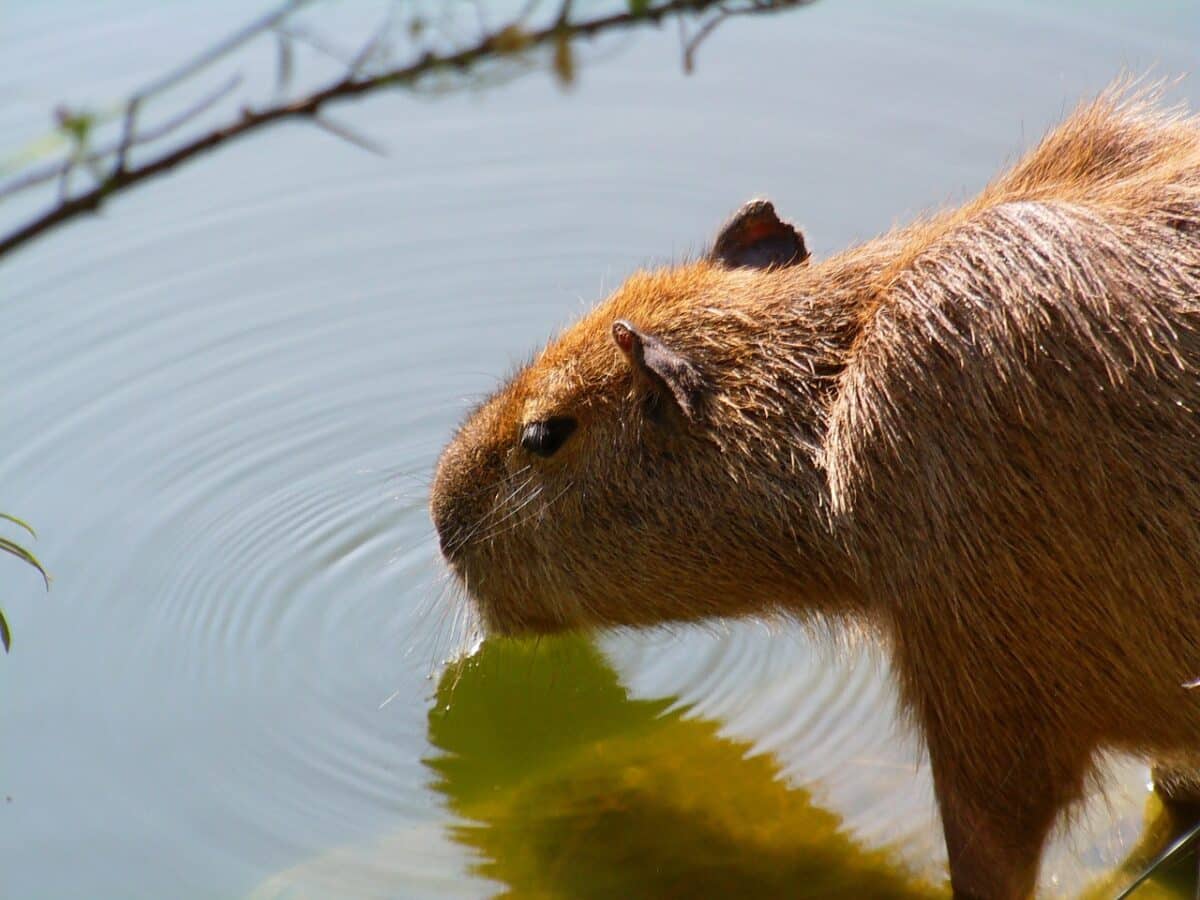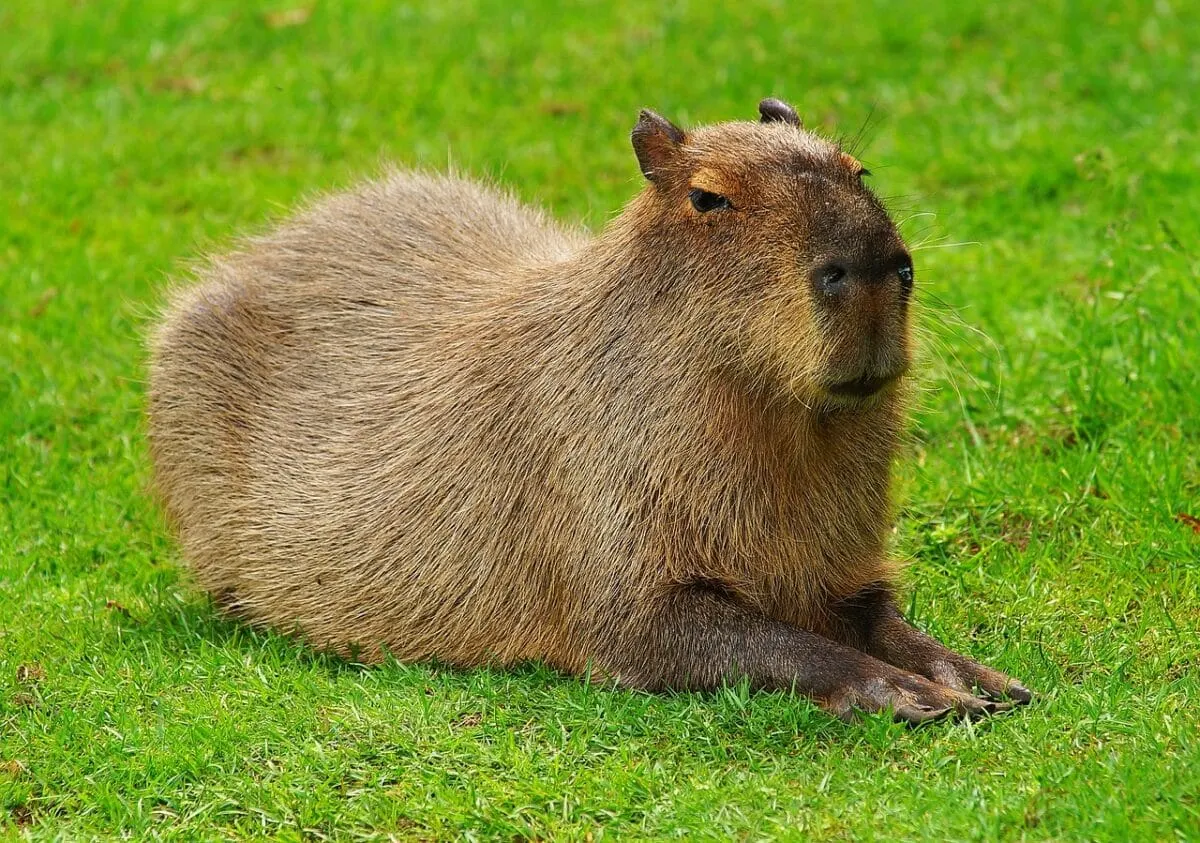Capybaras, the world’s largest rodents, have gained internet fame for their seemingly perpetual state of relaxation. Native to South America, these oversized guinea pig relatives have mastered the art of chilling to a degree that makes them the unofficial zen masters of the animal kingdom. From their unique social behaviors to their surprising physical abilities, capybaras embody a peaceful existence that humans often aspire to achieve. This collection of fascinating facts highlights why these remarkable creatures have earned their reputation as nature’s most laid-back animals, winning hearts worldwide with their unflappable demeanor and friendly disposition.
15. They’re Nature’s Ultimate Spa Enthusiasts

Capybaras take relaxation to professional levels with their dedicated spa routines. These semi-aquatic mammals spend up to 75% of their time in or near water, not just for safety from predators but for genuine enjoyment. They’re particularly fond of warm, shallow waters where they can partially submerge their bodies while keeping their noses and eyes above the surface. This position, often referred to as the “capybara soak,” allows them to regulate their body temperature in hot climates while achieving what appears to be a state of blissful meditation. Their skin produces natural oils that require regular moisture, making their spa time both practical and pleasurable—a perfect example of mixing business with leisure.
14. They’re The Universal Animal Friend

Perhaps the most compelling evidence of capybaras’ chill nature is their remarkable ability to befriend virtually any animal they encounter. Unlike most wild animals that maintain species boundaries, capybaras have been documented peacefully coexisting with crocodiles, monkeys, birds, cats, dogs, and even humans. Wildlife photographers and zoo keepers consistently capture images of various animals perching on the backs of unperturbed capybaras. This interspecies sociability isn’t just coincidental—capybaras possess a naturally non-aggressive temperament and release pheromones that actually calm other animals around them. Their reputation as “nature’s ottoman” comes from their willingness to serve as mobile resting spots for birds who enjoy picking insects from their fur, creating a mutually beneficial relationship.
13. They Practice Group Napping

Sleep isn’t just a necessity for capybaras—it’s a social activity. These communal creatures regularly engage in group napping sessions, huddling together in what experts call “capybara cuddle puddles.” A typical capybara herd of 10-20 individuals will synchronize their rest periods, creating a protective formation where some members remain semi-alert while others enjoy deeper sleep. This rotational vigilance system allows the entire group to maintain relaxation while ensuring safety. Young capybaras often sleep on top of adults, creating adorable multi-layered napping arrangements. These communal rest periods strengthen social bonds within the herd and demonstrate their highly developed cooperative nature—proving that even their approach to sleep embodies their laid-back philosophy.
12. They Have Built-In Waterproof Fur

Capybaras’ relaxed aquatic lifestyle is supported by their specially adapted coat. Their unique fur consists of an outer layer of guard hairs and a dense, water-resistant undercoat that prevents their skin from getting saturated during their extended water sessions. Unlike many animals who must dry off after swimming, capybaras can transition seamlessly between water and land without discomfort. Their fur also contains natural oils that enhance water repellency and protect their skin from constant moisture exposure. This biological adaptation allows them to remain in water for hours without the pruney skin humans experience, making their aquatic lounging sessions all the more comfortable. Some capybaras have been observed remaining partially submerged for up to six hours at a time—the equivalent of spending your entire afternoon in a bathtub without a care in the world.
11. They Can Sleep Underwater

Taking relaxation to extreme levels, capybaras have developed the remarkable ability to nap while partially submerged. Their eyes, ears, and nostrils are positioned at the top of their heads, allowing them to maintain minimal exposure while keeping the majority of their bodies underwater. When dozing in this position, they maintain a semi-conscious state where automatic breathing continues without full wakefulness. This adaptation serves the dual purpose of thermoregulation and predator avoidance, as their exposed profile is minimized. Their respiratory system automatically adjusts during these underwater naps, slowing their breathing rate by up to 30 percent. Scientists studying this behavior have noted that capybaras can maintain this state for up to 20 minutes before needing to shift position—truly mastering the art of the power nap in any environment.
10. Their Name Literally References Relaxation

The very etymology of “capybara” reflects their laid-back nature. The name derives from the Tupi-Guarani language family of indigenous South Americans, specifically from “ka’apiûara,” which roughly translates to “master of the grasses” or “one who peacefully grazes.” This naming highlights their unhurried approach to life and their tendency to spend hours calmly grazing on riverbank vegetation. In Venezuela, they’re called “chigüire,” in Brazil “capivara,” and in Argentina “carpincho”—but across all cultures, their names are spoken with affection for their gentle demeanor. Throughout South American folklore, capybaras frequently appear as symbols of tranquility and harmony with nature, further cementing their cultural identity as paragons of peaceful existence.
9. They’re Surprisingly Musical

Adding to their chill reputation, capybaras are one of the few non-primate mammals that show genuine appreciation for music. Zookeepers and wildlife specialists have documented capybaras responding positively to certain musical tones, particularly string instruments and soft wind instruments. They’ve been observed moving closer to music sources and assuming more relaxed postures when melodic sounds are played. This musical appreciation extends to their own vocalizations, which include purrs, clicks, whistles, and barks that vary in pitch and rhythm depending on their mood. When content, capybaras emit a soft, rhythmic purring sound that researchers compare to a gentle humming. Some wildlife sanctuaries have even incorporated music therapy into their capybara habitats, finding that classical compositions can reduce stress behaviors in captive populations.
8. They Practice Zen-Like Conflict Resolution

Unlike many social animals that establish dominance through aggressive confrontations, capybaras have evolved remarkably peaceful methods of conflict resolution. When disagreements arise within a herd, they rarely escalate to physical altercations. Instead, capybaras engage in a behavior zoologists call “staring contests,” where individuals face each other until one simply turns away, acknowledging the other’s position. These confrontations typically last less than two minutes and rarely involve physical contact. For more complex social negotiations, they use subtle vocalizations and body posturing rather than aggression. This non-violent approach to social hierarchy contributes to their cohesive group dynamics and low stress levels. Wildlife biologists have suggested that their conflict resolution strategies could serve as models for understanding peaceful coexistence in social species—including humans.
7. They’re Natural Meditators

Capybaras regularly engage in behavior that strongly resembles meditation practices. For several hours daily, they enter states of alert restfulness, where they remain still with a lowered heart rate while maintaining environmental awareness. During these periods, their breathing becomes notably regular and deep, similar to patterns observed in human meditation practitioners. Researchers monitoring capybara brain activity during these states have recorded patterns resembling those seen in meditating humans—increased alpha waves associated with relaxed alertness. These meditative states typically occur during dawn and dusk hours, often at the water’s edge where they sit motionless except for occasional slow blinks. This behavior isn’t just energy conservation; it appears to serve psychological functions similar to meditation, potentially helping them process environmental information and maintain their characteristic composure.
6. They Have Built-In Massage Mechanisms

Furthering their reputation as relaxation specialists, capybaras have developed mutual grooming routines that essentially function as massage therapy sessions. Herd members regularly engage in extended grooming sessions where they use their front teeth and paws to gently work through each other’s fur. These sessions target pressure points along the neck, back, and shoulders—areas where tension typically accumulates. The grooming produces endorphin releases in both the giver and receiver, creating a biochemical reward for this social bonding. Young capybaras learn these techniques by observing adults, eventually developing personalized “massage styles” that can be identified by researchers studying specific herds. These grooming sessions typically last 15-20 minutes and occur multiple times daily, contributing to their overall stress management system and reinforcing social cohesion.
5. They’ve Mastered the Art of Coexistence

Capybaras have developed symbiotic relationships with numerous species that showcase their exceptional tolerance and adaptability. The most famous of these relationships is with birds like cattle egrets and yellow-headed caracaras, which perch directly on capybaras to feed on insects in their fur. Rather than viewing this as an intrusion, capybaras welcome these natural pest control services, often tilting their heads to allow birds better access to tick-prone areas. They’ve also developed mutually beneficial relationships with turtles and small fish, which clean algae from their submerged portions during water soaks. In some regions, they’ve been observed allowing small monkeys to ride on their backs when crossing water, creating natural ferry services. These diverse interspecies arrangements demonstrate an unusual level of cooperation rarely seen in wild mammals, highlighting their exceptional capacity for peaceful coexistence.
4. They’re Expert Conservationists of Energy

The capybara’s relaxed approach to life isn’t just a personality trait—it’s an evolutionary strategy for energy conservation. Their metabolic efficiency is remarkable among mammals their size, burning fewer calories while maintaining functionality. They achieve this through specialized digestive systems that extract maximum nutrition from fibrous vegetation and through behavioral adaptations that minimize unnecessary movement. When not actively feeding or socializing, capybaras enter a state of “active rest” where they remain alert but motionless, conserving energy while maintaining vigilance. This strategic laziness allows them to survive in environments where food sources may be scattered or seasonal. Some capybaras have been observed remaining in the same location for up to eight hours when conditions are favorable, moving only to adjust their position relative to the sun or water—a lifestyle that perfectly balances survival needs with minimal exertion.
3. They Have Specialized Chill Zones

Capybaras create and maintain dedicated relaxation areas within their territories, demonstrating remarkable environmental engineering. These “chill zones” typically feature a combination of shade, proximity to water, and elevated vantage points for safety. The entire herd participates in maintaining these areas by clearing vegetation and creating smooth, comfortable resting surfaces through repeated use. These zones become central to herd life, serving as social gathering points and communal nurseries where young capybaras are watched by multiple adults. The locations aren’t randomly selected—they’re strategically positioned to optimize sun exposure during mornings and evenings while providing shade during midday heat. Some capybara herds have been documented using the same relaxation zones for generations, creating well-worn paths between these locations and their feeding grounds—essentially establishing capybara resorts within their territories.
2. They’re Naturally Buoyant

Contributing to their aquatic relaxation abilities, capybaras possess natural buoyancy that allows them to float effortlessly. Their bodies contain specialized fat distribution and air pockets within their digestive systems that create natural flotation devices. This biological buoyancy means they can rest on water surfaces with minimal energy expenditure, often assuming a position where only their nostrils, eyes, and the top of their head remain above water. They can maintain this position for hours, occasionally using gentle foot movements to adjust their location. This floating ability allows them to rest while simultaneously avoiding predators and keeping cool—a multitasking approach to relaxation. Young capybaras instinctively know how to float from birth, though mothers stay close until they perfect their technique. This natural buoyancy represents yet another adaptation that supports their water-loving, laid-back lifestyle.
1. They Practice Social Thermoregulation

Capybaras have developed sophisticated group temperature regulation strategies that promote communal comfort. During cooler weather, herds form tight sleeping groups where body contact is maximized, creating shared warmth that reduces each individual’s energy expenditure. In hot conditions, they coordinate group soaking sessions where they enter water together and position themselves to create optimal cooling effects through water circulation. They’ve even been observed taking turns in the most comfortable spots, with individuals rotating through prime positions with minimal conflict. This cooperative approach to comfort extends to their young, with multiple adults creating protective formations that shield babies from temperature extremes. This social thermoregulation represents a collective approach to relaxation, where individual comfort is enhanced through group coordination—further evidence of their community-oriented chill philosophy.
Conclusion: Nature’s Zen Masters

Capybaras stand as living embodiments of stress-free existence, having evolved biological, behavioral, and social adaptations that prioritize tranquility and cooperation. Their remarkable ability to maintain calm in diverse environments while fostering peaceful interactions across species boundaries offers a compelling model of balanced living. The capybara’s approach to life—conserving energy, avoiding unnecessary conflict, enjoying simple pleasures, and prioritizing community well-being—represents wisdom that transcends their rodent classification. As humans increasingly seek mindfulness and stress reduction in our hectic world, perhaps these gentle giants of the rodent family have been modeling the path to contentment all along, reminding us that sometimes the most profound approach to life’s challenges is simply to remain unruffled, present, and connected to both nature and community.
- 12 Fascinating Shark Facts And 3 That Are Totally Wrong - August 21, 2025
- 11 Animals That Can Clone Themselves - August 21, 2025
- 15 Cat Breeds Vets Secretly Wish You’d Stop Buying - August 21, 2025

